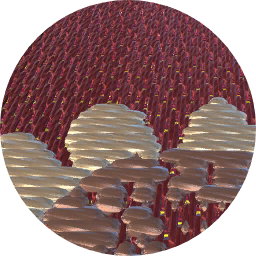Description
Textile fragment with crowned lions within a network of swooping half-palmettes, in red, blue and yellow.
This design was popular with Christian patrons and survives in numbers that imply it was made in quantity. It may have originated as a simplified form of the lion-on-lotus design in Nasrid brocades. The iconography may suggest a desire to promote the propagandistic message of the triumph of Christianity over Islam - the lions stand above an upturned shield and trample on pomegranates. (M. Rosser-Owen, 2010).
This silk has the same motif and the same colour combination as that used in a dalmatic currently in the cathedral in Avila, Spain. The dalmatic may have been made up in the late 17th century as the panels on both sleeves and front and back have a chinoiserie design of about that period. (Nicolas Gonzalez y Gonzalez. Ornamenta Sacra. Catalogacion de los Ornamentos Liturgicos de la Catedral de Avila. Salamanca: Publicaciones de la Catedral de Avila, 2003, pp.160-1).
A similar piece is illustrated in Monique King & Donald King. European Textiles in the Keir Collection 400 BC - 1800 AD, p. 62, no. 39, described as Silk lampas, Southern Spain late 15th or early 16th century, acquired from Spink and Son, London. It has been reassembled from a number of fragments and the pattern is imperfect at some of the joins. Weave is lampas with five-end satin ground and tabby pattern. Main warp threads generally in pairs, and the binding warp threads are of red silk, Z-twisted. Main weft is red silk, pattern wefts of dark green, yellow and white silk. The Kings write that variants are known in many museum collections, some include a heraldic shield associated with Nasrid dynasty of Granada; they were known in Venice, Falke indicating that the pattern appears in a Deposition by Rocco Marconi (active 1504-30) in the Accademia (Falke, II, p. 66).
Samples of coloured threads from this object have been taken and are being analysed as part of a collaboration between the V&A and the Spanish Research project "Caracterización de als producciones textiles de la Antigüedad Tardía y Edad Media temprana: tejidos coptos, sasánidas, bizantinos e hispanomusulmanes en las colecciones públicas españolas" ("Characterization of Late Antique and Early Medieval textile production: Coptic, Sasanian, Byzantine and Spanish Muslim textiles in Spanish national collections") (HAR2008-04161) directed by Dr Laura Rodríguez Peinado, Universidad Complutense de Madrid, Dpt. de Historia del Arte I (Medieval).








